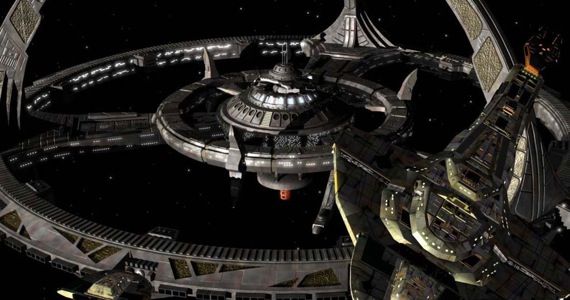This past Thursday saw the 20th anniversary of Star Trek: Deep Space Nine, also known by those with taste as "The best of the Star Trek series from the 1980s and '90s." There are, however, those who have avoided the show due to the (admittedly foreboding) reputation that it has developed as overly dark and continuity-laden, especially when compared to the other Treks of the time, and remain unaware of the show's greatness. For them, then, here are five episodes to introduce Deep Space Nine to the wary.
Far Beyond The Stars
From the show's sixth season, one of the best examples of what is often claimed to be a "classic Trek trope": The show using science fiction to comment on contemporary society. Or, in this case, contemporary and period society, as Sisko wakes up the life of a pulp writer in the 1950s and has to deal with the racist attitudes of the time. Oddly beautiful, this essentially standalone episode is Deep Space Nine - and Star Trek as a whole - at its best.
Trials and Tribble-ations
"Classic Trek" in another sense altogether, the series' celebration of the 30th anniversary of Star Trek saw the cast return to not only the time period of the original series, but an actual episode of the series itself, thanks to time travel and some particularly fun directing, costuming and special effects choices. One of Deep Space Nine's hidden talents is its sense of humor, and this episode is a great example of how funny the show could be.
In The Pale Moonlight
At times, Deep Space Nine pushed the envelope in all manner of ways for Star Trek, especially the idea that Starfleet officers were necessarily paragons of virtue. "In The Pale Moonlight" is a particularly political episode of the series - and definitely of Trek as an overall franchise - and illustrates the ways in which war can force good men to do bad things. Unlike other episodes in this list, this is one that's very closely tied into the overall arc of the series, but one that's also so good that it stands up to being watched alone (Although you'll likely end up wanting to watch more to see what happens afterwards).
The Visitor
An alternate timeline allows the series to explore the loss of a parent, and the nature of grief, in this episode where Jake Sisko - a teenager in the series proper, but an adult in this storyline - tries to discover what happened to his father after his mysterious disappearance years ago. Simultaneously a hard SF story and one centered around that old chestnut, the Power of Love, "The Visitor" is considered by many Deep Space Nine's finest hour.
It's Only A Paper Moon
Something that Deep Space Nine did so well, and that other Treks didn't really have the ability to do, was explore the impact and after-effects of major events. "It's Only A Paper Moon" is a great example of that, as Nog retreats into fantasy to avoid dealing with his post-traumatic stress following the loss of his leg in an earlier episode. Although that summary makes this episode sound like a downer, the actual episode is surprisingly uplifting, in part due to the fantasy Nog retreats into, and also the performances from all involved. Plus, any episode that allows for an appearance of Vic Fontaine, the virtual lounge singer that lives in a holodeck, is worth checking out, and this episode is literally full of him.

